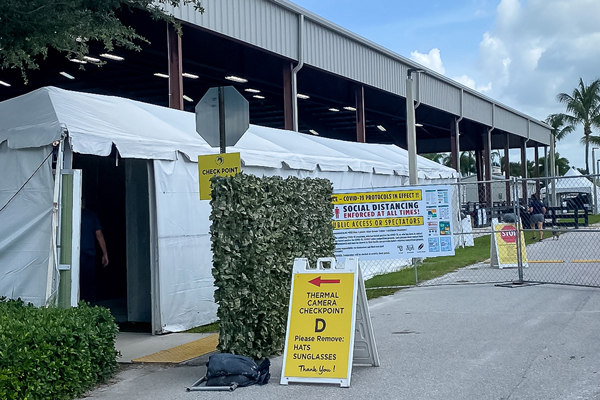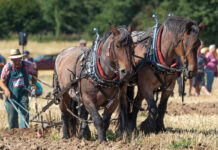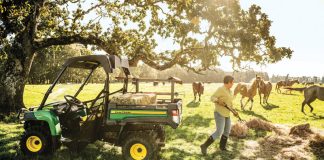
The novel coronavirus, now known as severe acute respiratory syndrome coronavirus 2 (SARS-CoV-2), causes the disease known as coronavirus disease 2019, or most commonly known as COVID-19. In March 2020, the World Health Organization (WHO) declared the COVID-19 outbreak a pandemic. Just like every industry, COVID-19 has caused numerous impacts to every breed, discipline, and partipant within the horse industry.
There are two types of tests for COVID-19, one which tells you if you have an active viral infection and the other tests for antibodies against the disease, which indicates if you have been exposed and built antibodies in response to the virus. Horse Illustrated has been covering the impact of COVID-19 on the horse industry as the pandemic has progressed. To view that complete coverage, visit www.horseillustrated.com/tag/coronavirus.
COVID-19 and the Horse Industry
• Although equines can contract a form of coronavirus, it is a different virus than COVID-19. As of mid-June no evidence had been found to show that horses could get the virus from humans or vice versa. Cases of COVID-19 in wild and domestic felines and domestic canines have been documented, however.
• The American Horse Council (AHC) has released data from their COVID-19 horse industry survey, which resulted in 105 survey responses representing 974 horses through June 5, 2020. The respondents were from all sizes of organizations and businesses and included individuals from 33 states. Participants were from all sectors including: 12% racing; 39% competition; 27% recreational riding, and 22% other. Participants also came from diverse roles in the industry, including: 39% owners; 15% trainers; 8% lesson providers; 5% breeders; 5% professional service providers and 28% other.
The impact on participants’ livelihoods included: 41% who had to scale back their business; 35% doing remote work; 21% that had closed their business; 17% who were working for reduced wages; 8% who were laid off; 7% who were furloughed; and 24% had other impacts (Note: respondents were asked to indicate all impacts that applied).
When asked about types of assistance needed: 39% needed no assistance; 24% wanted grants or disaster relief; 14% wanted a business loan; 11% needed free feed, hay, or vaccines; 5% used fundraising ideas; 4% needed consulting services, and 3% needed volunteers.
When asked how many horses might be displaced, participants stated a total of 163 (or 17%) of the total population represented might need fostering or adoption. To participate in their next round of this survey, visit www.horsecouncil.org.
• AHC has also lobbied Congress for the passage of two bills that may prove beneficial to the horse industry during the pandemic. The first is the CARES Act—and its related bills—which have passed and include small business support and the Payroll Protection Program. The second, newer bill that was being considered in Congress in mid-June is the Great American Outdoors Act (S. 3422), which is aimed at “getting Americans outside while promoting the health of recreational riders and other outdoor enthusiasts,” according to the AHC’s Director of Policy and Legislative Affairs, Bryan Brendle.
• Equestrian businesses, farms and ranches seeking help during the pandemic have a few resources available. Financial aid and other assistance may be applied for through the U.S. government’s CARES Act, but also through two equestrian support organizations: the Equestrian Aid Foundation (EAF) at www.equestrianaidfoundation.org and the Show Jumping Relief Fund at www.showjumpingrelieff.wixsite.com/home. As of mid-May, each organization had processed more than 200 requests for grants.
• Some states also have other charitable organizations that residents can turn to for help. That list can be found at the United Horse Coalition’s website at www.unitedhorsecoalition.org/covid-19-resources.
• The University of Turin in Italy, the Italian Ministry of Sport, and the Italian Committee (CONI) have conducted a survey calculating the probabilities of COVID-19 contamination through sport. Several Olympic sports were assigned a “risk indicator” between 0 (almost non-existent risk) to 4 (very high risk). Training conditions, competitions, and audience presence were variables considered to assess each sport. While equestrian sport received a 0 risk level (as well as other sports like tennis and golf), the risk of contamination increases when riding in a group, such as polo or racing. However, these disciplines are still considered a 1 risk level (low). Team sports were found to have a higher probability of contamination, beginning with a 2 for risk level for sports like water polo. Soccer was determined to be a 3 risk level, while volleyball, basketball, and American football have the highest probability at a 4 risk level.
• For those that compete through the United States Equestrian Federation (USEF), USEF’s website offers a comprehensive COVID-19 information page under the “Breaking News” banner near the top of their homepage. All of the USEF’s rule changes, announcements, and resources are there, as well as links to COVID-19 information from their affiliate organizations. There is also a state-by-state COVID tracker document, which is updated frequently.
• For those that compete internationally, the International Equestrian Federation’s (FEI’s) COVID-19 information page can be found at https://inside.fei.org/fei/covid-19.
• For those competing in Canada, Equine Canada’s COVID-19 information page, including information on financial aid, can be found at www.equestrian.ca.
• COVID-19 news from Europe: Pascal Renauldon reports an online benefit auction in France in early May called the “Treasures of Champions” raised over 36,000 Euros to benefit riding schools in the country during the pandemic. On June 1, Kim Lundin said Sweden was starting a gradual return to showing in June and reports that barn owners had the choice to stay open with precautions or close completely during the pandemic. In Germany, Jan Tönjes explains that each state had different restrictions depending on the severity of the outbreak, and that, as of early June, shows in some states were beginning again with restrictions similar to the U.S. (limited number of people per horse, masks, social distancing, etc.). In the United Kingdom, shows began again in June and July, starting with schooling and smaller rated shows first.
For more information about COVID-19 as a whole, please visit the Centers for Disease Prevention and Control (CDC) website at www.cdc.gov and the World Health Organization (WHO) at www.who.int. For more information on all clinical trials being conducted to develop a vaccine, visit the website for the National Institute of Health at www.nih.gov/coronavirus.





